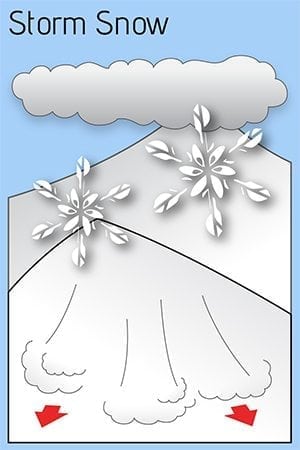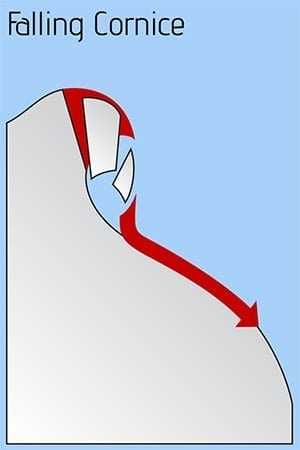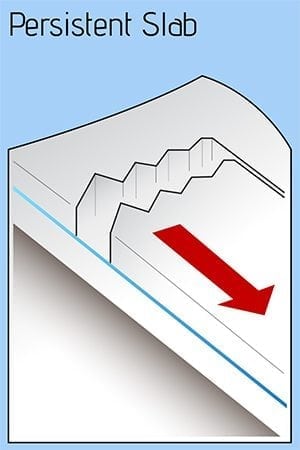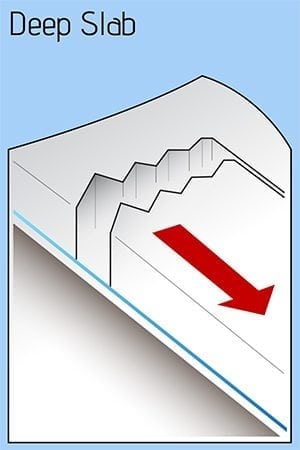Valdez
Above 4,000ftConsiderable
2,000 to 4,000ftConsiderable
Below 2,000ftModerate
Degrees of Avalanche Danger
Avalanche Problems
Problem 1
The current storm has delivered 3-4 inches of new snow on Thompson Pass as of 6 am with strong winds that shifted from southeast to northeast last night. An additional 2-4 inches is expected with a continuation of strong winds that may increase in intensity as the storm departs and precipitation fades. This round of snowfall is expected to favor the Intermountain and Continental zones with our Maritime zone expecting lower amounts.
New snow will be falling on wind damaged surfaces in most locations in close proximity to the road corridor. Expect this interface to act as bed surface with poor bonding initially. Today it will be important to pay attention to new snow amounts and the amount of wind redistribution that has occurred. Changing wind directions has likely created thickened storm slabs on a variety of aspects.
Flat light will likely make it difficult to judge wind distribution over a larger area. Watch for signs of instability such as shooting cracks, collapsing or recent avalanche activity that would indicate unstable snow at the surface.
Likelihood:
- Almost Certain
- Very Likely
- Likely
- Possible
- Unlikely
Size:
- Historic
- Very Large
- Large
- Small
Trend
- Increasing
- Steady
- Decreasing
Problem 2
An abnormal amount of Cornice falls have been reported last week that triggered very large avalanches (D2-D3). Cornices have been observed and reported as being larger than normal and poorly attached. Cracks on ridge tops showing cornices separating from ridge lines have been observed and reported. Cornices will continue to grow in size with strong winds and moderate snowfall.
Cornices are an objective mountain hazard that should always be a concern. Although, recent activity strongly shows that we need to keep an extra cautious approach to avoiding overhead exposure to cornices. Avoid traveling below or on top of cornices. The avalanches that cornice fall has recently produced are unsurvivable events.

Likelihood:
- Almost Certain
- Very Likely
- Likely
- Possible
- Unlikely
Size:
- Historic
- Very Large
- Large
- Small
Trend
- Increasing
- Steady
- Decreasing
Problem 3
There are currently 3 persistent weak layers that exist in our snowpack that are worth noting. 2 of these are unlikely to be affected by human triggers at this point. The one layer that is possible to be affected, is the 2/23 buried surface hoar. Wind slabs created last weekend may remain reactive longer than what is typical where they are deposited on this layer. New snow will add stress to this layer and disguise previous surface texture. The most likely area to encounter a reactive 2/23 BSH will be at mid elevations in wind sheltered terrain.
Other persistent layers of concern include the 1/14 buried surface hoar which is likely the responsible failure plane of some very large recent avalanches triggered by cornice fall. Human triggered avalanches at this layer are currently unlikely due to their depth. But if they were to occur, would likely be in areas where a thinner snowpack exists and this layer is still relatively close to the surface (less than 3 feet).
The last layer we are tracking is the 1/25 rain crust/ facet combo. This layer exists below 2500′. Collapsing in the Intermountain and Continental zone has been observed at low elevations failing at this layer. Natural and human triggered avalanches have not been reported at this layer and stability tests continue to show a lack of results and rough shears. Even though human triggered avalanches are unlikely at this layer, it is still worth investigating if choosing to travel in steep consequential terrain at low elevations.
Likelihood:
- Almost Certain
- Very Likely
- Likely
- Possible
- Unlikely
Size:
- Historic
- Very Large
- Large
- Small
Trend
- Increasing
- Steady
- Decreasing
Problem 4
Weak snow created by early season cold temps, dry conditions and strong north winds have showed poor structure near the base of the snowpack. This weak snow has been dormant through the majority of the season with human triggered avalanches being unlikely at this layer. As the sun has come out last week several very large natural avalanches have occurred with cornice and ice falls being the triggers. Human triggers remain unlikely at this layer, although these events show that large triggers can affect this weak snow. Cornice fall will be the most likely trigger to affect this weak snow, although it is possible that a large group could have the same affect. Avoid overhead exposure to cornices.
In most location facets near the ground have been found to be rounding and unreactive in stability tests. In thin areas of the snowpack basal facets have been found to be more developed. If you find it is possible to push a ski pole to the ground in areas you travel, assume that a weak faceted snowpack exists in that location. These areas could act as a trigger point.
Likelihood:
- Almost Certain
- Very Likely
- Likely
- Possible
- Unlikely
Size:
- Historic
- Very Large
- Large
- Small
Trend
- Increasing
- Steady
- Decreasing
Avalanche Activity
Below is a summary of observed Avalanche activity from the last 7 days. Avalanches that were noted earlier in the season can be viewed by clicking the link below.
If you trigger or observe an avalanche consider leaving a public observation.
2/24- Natural D2.5 wind slab avalanche that failed on 2/23 BSH in the Tsaina Valley / S-SE aspect ~6000’/ ran ~3500 vertical (full track)/ crown ~1 foot deep and ~2000′ wide. SS-N-R4-D2.5

2/22- Natural D 2.5 cornice fall avalanche was reported on a NW aspect/ ~6000 in the books. 

2/20- Numerous D1-D2 natural and human triggered avalanches were observed and reported up to 1 foot in depth on a variety of aspects. These occurred in areas where fresh wind slabs were present.
– D3 natural avalanche observed on Snoopys (Port of Valdez). NW aspect/ ~5000’/ ran ~3500 vertical feet with a track length of approximately 1 mile mapped on Google Earth. This was a hard slab avalanche the failed at weak layer in the mid snowpack. HS-N-R4 D3. No other avalanches of this size have been observed or reported in our forecast area.


Weather
Check out our updated weather tab! A collection of local weather stations are available for viewing with graphs and tabular data included.
NWS Watches and warnings
...WINTER WEATHER ADVISORY REMAINS IN EFFECT UNTIL 7 PM AKST THIS EVENING FOR THOMPSON PASS... * WHAT...Blowing snow. Additional snow accumulations of 2 to 4 inches. Winds gusting as high as 45 mph. * WHERE...Thompson Pass. * WHEN...Until 7 PM AKST this evening. * IMPACTS...Travel could be very difficult. Reduced visibility as low as one half mile with blowing snow. * ADDITIONAL DETAILS...Snow and northeasterly gusty winds will develop early this morning and persist through this evening before tapering off. A second round of gusty winds, along with blowing and drifting snow, is possible Thursday.
NWS Point forecast for Thompson Pass
Date Wednesday 03/01/23 Thursday 03/02/23 Time (LT) 06 12 18 00 06 12 18 00 06 Cloud Cover OV OV OV OV OV OV OV OV OV Cloud Cover (%) 100 95 85 80 85 85 85 85 80 Temperature 13 14 15 10 8 13 13 8 5 Max/Min Temp 16 8 16 4 Wind Dir NE N N N N N N NE N Wind (mph) 23 24 19 23 28 28 24 25 13 Wind Gust (mph) 43 41 35 37 42 43 39 36 31 Precip Prob (%) 80 60 30 30 20 10 0 5 0 Precip Type S S S S S 12 Hour QPF 0.14 0.03 0.01 0.00 12 Hour Snow 2.9 0.0 0.0 0.0 Snow Level (kft) 0.0 0.0 0.0 0.0 0.0 0.0 0.0 0.0 0.0
Click on link below for Thompson Pass weather history graph:

| Date:
03/01 |
24 hr snow | HN24W* | High temp | Low temp | 72 hour SWE* | March snowfall | Seasonal snowfall | Snowpack Depth |
| Valdez | 2 | N/O | 25 | 11 | .3 | 2 | 218 | 62 |
| Thompson pass | 3 | N/O | 16 | -2 | 0 | 3 | 356 | N/O |
| 46 mile | Trace | – | 15 | -10 | 0 | 0 | ~85** | 42 |
*HN24W- 24 hour Snow water equivalent in inches
*SWE– Snow water equivalent
**46 mile seasonal snowfall total begins December 1st.
Additional Information
Click on the link below for a running summary of the seasons weather history.
Announcements
The avalanche hazard is Considerable above 2000′ and Moderate below. Human triggered avalanches are likely up to 1 foot in depth, natural avalanches are possible. The current storm system is forecasted to deliver 4-8 inches of new snow along with strong winds. Pay attention to new snow depths and wind affect. Watch for signs of instability such as shooting cracks and collapsing.
Posted by Gareth Brown 03/01 8:15 am.
For a description of current avalanche problems, weather information, season history and more click the (+ full forecast) button. Avalanche forecasts will be issued Wednesday-Sunday.
If you have pictures of recent natural or human triggered avalanches or notice signs of instability such as shooting cracks or collapsing, leave an observation to help improve forecast accuracy.



